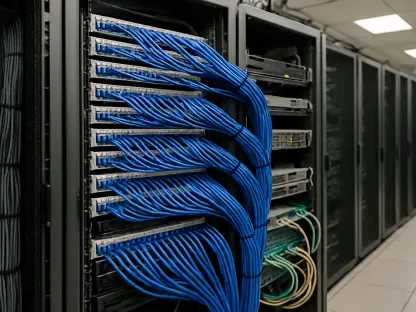Nvidia has announced a significant enhancement in storage read bandwidth, boosting it by nearly 50% through an advanced integration of its Spectrum-X Ethernet networking equipment. This breakthrough combines the Spectrum-4 Ethernet switch and the BlueField-3 SuperNIC smart networking card, leveraging RoCE v2 technology for remote direct memory access over Converged Ethernet. Along with its introduction of adaptive routing and congestion control, this development represents a cutting-edge solution to manage data packet flow more efficiently, ensuring more reliable and consistent performance for AI applications.
Technical Advancements in Networking Equipment
Spectrum-4 SN5000 Switch Capabilities
The Spectrum-4 SN5000 switch is a core component of this innovation, offering significant bandwidth capabilities that are pivotal for modern data centers and AI workloads. With a staggering 800 Gbps across 64 ports and a total throughput of 51.2 Tbps, the switch is designed to handle the immense data loads typical of AI training processes and large-scale deployments. This increased bandwidth ensures seamless, high-speed data transfer, which is crucial for maintaining the performance and responsiveness of AI systems, especially when handling large datasets and training complex models.
Adaptive routing is another key feature of the Spectrum-4 switch, allowing for more efficient packet transmission by utilizing less congested pathways. This advanced capability significantly mitigates problems associated with data collisions, a common issue in traditional Ethernet scenarios. By dynamically rerouting data packets to avoid congested pathways, adaptive routing enhances the overall bandwidth utilization, leading to smoother and more efficient data flow. The BlueField-3 DPU plays a crucial role in this process by reordering incoming packets accurately, ensuring that data is processed in the correct sequence without the need for retransmission.
BlueField-3 SuperNIC and RoCE v2 Technology
The integration of the BlueField-3 SuperNIC smart networking card with RoCE v2 technology is another critical factor contributing to Spectrum-X’s remarkable performance improvements. RoCE v2 offers remote direct memory access over Converged Ethernet, which allows for direct data transfer between memory locations without involving the host CPU. This capability is essential for reducing latency and increasing data transfer speeds, both of which are crucial for AI applications that require rapid and massive data movement to prevent processing bottlenecks.
The combination of the BlueField-3 DPU’s packet reordering capabilities and RoCE v2 technology allows for higher bandwidth utilization and improved reliability in data transmission. This integration ensures that data packets arrive in sequence without the need for retransmission, which traditionally hinders Ethernet’s performance with out-of-sequence arrivals. These enhancements are particularly beneficial for tasks such as checkpointing and data fetching, which demand consistent and robust data transfer rates to maintain optimal performance in AI applications.
Impact on AI and Storage Efficiency
Enhancing Large Language Models
Nvidia’s advancements in Spectrum-X are especially significant for the development and deployment of large language models (LLMs), which require extensive data handling and processing power. Faster data transmission ensures GPUs do not remain idle, ultimately maximizing processing efficiency and reducing the overall time required to train and fine-tune these massive models. In benchmarking tests using the Israel-1 AI supercomputer and Nvidia HGX #00 GPU servers, Spectrum-X demonstrated superior performance over standard RoCE v2, with read bandwidth improvements ranging from 20% to 48% and write bandwidth enhancements between 9% and 41%.
These performance gains translate to substantial time savings and greater resource utilization, which are critical factors for organizations training large-scale AI models. By minimizing data transmission bottlenecks, Spectrum-X enables more efficient use of GPU processing power, ensuring that AI models can be developed and deployed more rapidly. This is particularly important for industries that rely on real-time data processing and rapid AI model iteration, as it allows for faster innovation and more competitive edge.
Collaboration with Storage Vendors
Nvidia emphasizes the importance of checkpointing as a method to increase efficiency, allowing processes to resume from a saved state after a failure rather than starting from scratch. This technique not only saves time but also reduces the computational resources required for reprocessing. The company collaborates with leading storage vendors, including DDN, VAST Data, and WEKA, to further integrate and refine their solutions with Spectrum-X. This collaboration aims to create optimized, high-performance storage solutions that can meet the demanding requirements of AI applications, reinforcing Nvidia’s commitment to advancing storage technology for AI.
Through these partnerships, Nvidia seeks to enhance its Spectrum-X technology continually, ensuring it remains at the forefront of AI storage networking innovation. These efforts highlight the company’s dedication to providing robust, scalable storage solutions that can handle the increasing demands of AI workloads. By working closely with storage vendors, Nvidia is poised to deliver cutting-edge technologies that enable faster, more efficient data handling, ultimately driving the progress of AI research and application.
Looking Ahead to Future Developments
Nvidia has revealed a major improvement in storage read bandwidth, increasing it by almost 50% through an advanced integration of its Spectrum-X Ethernet networking technology. This innovation combines the Spectrum-4 Ethernet switch and the BlueField-3 SuperNIC smart networking card, utilizing RoCE v2 (Remote Direct Memory Access over Converged Ethernet) technology. This integration facilitates efficient data transmission and lowers latency. Furthermore, Nvidia has introduced adaptive routing and sophisticated congestion control mechanisms to better manage the flow of data packets. This advancement aims to deliver more consistent and dependable performance, particularly for AI applications. By handling data traffic more efficiently, these innovations promise to support the growing demands of AI-driven tasks, ensure smoother operations, and enhance the overall reliability of AI systems. As data-intensive applications continue to evolve, Nvidia’s new technology sets the stage for more robust and efficient network solutions.









